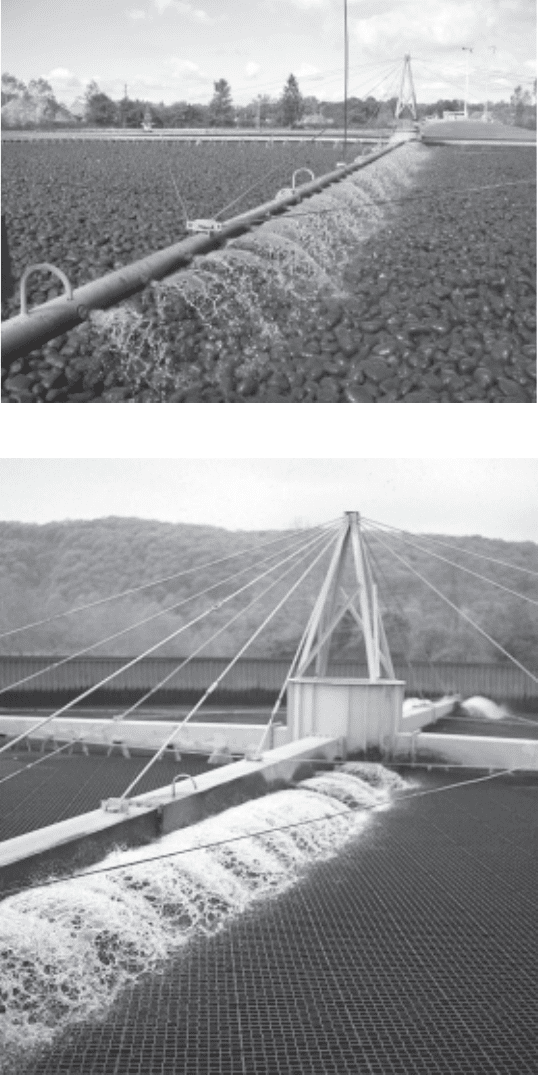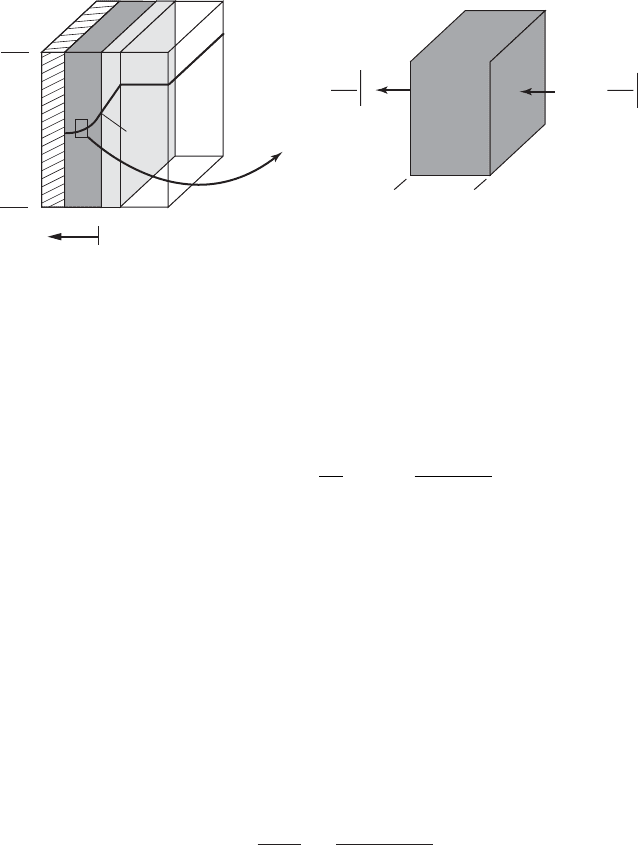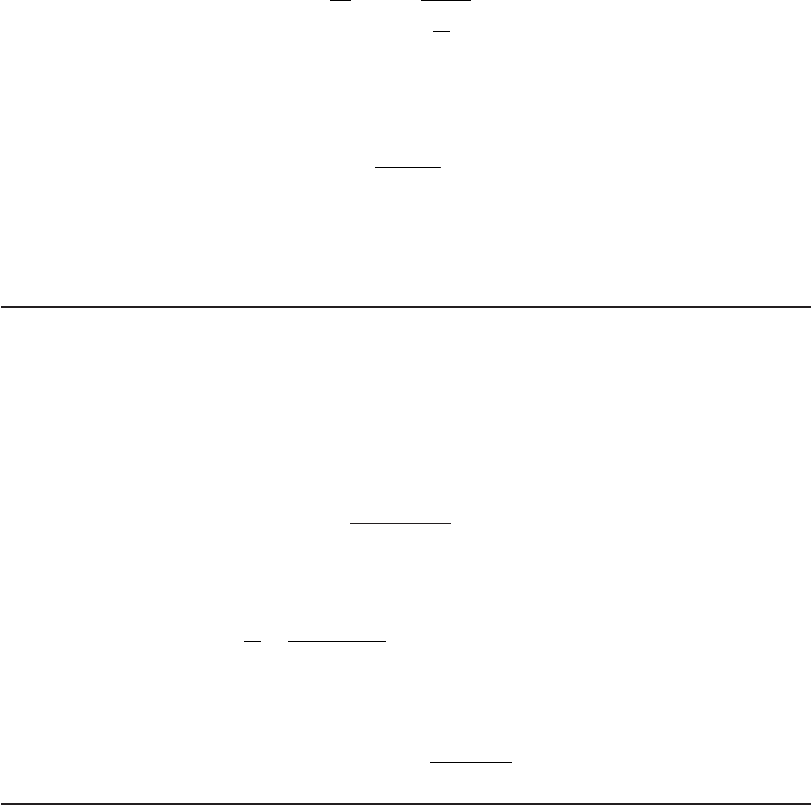Water and Wastewater Engineering
Подождите немного. Документ загружается.


SECONDARY TREATMENT BY ATTACHED GROWTH AND HYBRID BIOLOGICAL PROCESSES 24-3
FIGURE 24-1
Trickling filters, rock media ( a ) and
synthetic media ( b ) . Sources: M. L.
Davis and Brentwood Industries.
( a )
( b )
24-4 WATER AND WASTEWATER ENGINEERING
These media offer larger surface areas for slime growths (typically 90 square meters of surface area
per cubic meter of bulk volume, as compared to 40 to 60 square meters per cubic meter for 75 mm
rocks) and greatly increase void ratios for increased air flow. The materials are also much lighter
than rock (by a factor of about 30), so the trickling filters can be much taller without facing struc-
tural problems. While the rock in filters is usually not more than 3 m deep, synthetic media depths
may reach 12 m. This reduces the overall space requirem
ents for the trickling filter portion of the
treatment plant.
O xygen is typically supplied to the rock filters by natural draft ventilation of air. Deeper
synthetic media filters may be provided with forced draft ventilation (called a biological aerated
filter or BAF). They may be designed with an aerobic zone at the top and an anoxic zone at the
bottom to promote denitrifi
cation.
A 10-year side-by-side study of the performance of full scale conventional activated sludge
and a biological aerated filter found the following (Hansen et al., 2007):
• Both systems are operationally reliable and easy to handle and maintain.
• The BAF is less sensitive to both hydraulic and BOD load fluctuations.
• The BAF maintains better and more stable nitrification at both normal and low temperatures.
• Activated sludge unit operating costs are less than BAFs.
Biofilters
This process is not used to treat wastewater. It is used to treat odors from wastewater treatment
processes. Biofilters are packed bed filters. The packing material is often one of the following
materials: peat, compost, or a m ixture of compost and other materials such as perlite, oyster
shells , and limes
tone. As the od orous gas passes through the biofilter, two processes occu r
simultaneously: absorption/adsorption and bioconvers ion. The gases are absorbed into the moist
surface biofilm layer. Microorganisms, principally bacteria, actinomycetes, and fungi that are
attached to the media, oxidize the absorbe
d/adsorbed gases. Moisture content and temperature
are important environmental conditions that must be maintained.
Over 50 papers on the performance of biofilters have been written in the last two decades.
Iranpour et al. (2005) presents a literature review of the effec tiveness of these units for air
pollution control. Many articles on modeling and d
esign appear in the Journal of the Air & Waste
Management Association.
24-3 ATTACHED GROWTH DESIGN PRINCIPLES
The growth conditions and the hydrodynamics of the trickling filter control the thickness of the
biofilm. The thickness may range from 100 m to 10 mm. A stagnant liquid layer called the
diffusion layer separates the biofilm from the bulk liquid wastewater ( Figure 24-2a) . Substrate,
oxy gen, and nutrients diffuse a
cross the stagnant liqu id layer to the biofilm, and products of
biodegradation diffuse from the biofilm to the bulk liquid layer.
A s shown in Figure 24-2a , the substrate concentration, S
s
, decreases with biofilm depth as
it is consumed and diffuses into the film. As a result, the process is said to be di ffusion limited.
The rate of mass transfer is termed the substrate surface flux. It is expressed as mass per unit area

SECONDARY TREATMENT BY ATTACHED GROWTH AND HYBRID BIOLOGICAL PROCESSES 24-5
per unit time (g/m
2
· d). The substrate flux is a function of the substrate diffusion coefficient and
concentration (Metcalf & Eddy, 2003):
rD
dS
dx
D
SS
L
sf w w
bs
()
(24-1)
where r
sf
rate of substrate surface fl ux, g/m
2
· d
D
w
diffusion coefficient of substrate in water, m
2
/ d
dS / dx substrate concentration gradient, g/m
3
· m
S
b
bulk liquid substrate concentration, g/m
3
S
s
substrate concentration in outer layer of biofilm, g/m
3
L effective thickness of the stagnant fi lm, m
The thickness of the stagnant layer will vary with the fluid velocity. Higher velocities will result
in thinner films and greater substrate flux rates (Grady et al., 1999).
A mass balance around the differential element ( dx ) shown in Figure 24-2b yields the follow-
ing general equation for the change in substrate conc
entration within the biofilm:
D
dS
dx
SX
YK S
e
fmf
sf
2
2
0
()
⎛
⎝
⎜
⎞
⎠
⎟
(24-2)
where D
e
effective diffusivity coeffi cient in biofi lm, m
2
/ d
m
maximum specific bacterial growth rate, g new cells/g cells · d
S
f
substrate concentration at a point in the biofilm, g/m
3
X biomass concentration, g/m
3
Y yield coefficient, g/g
K
s
half-velocity constant, g/m
3
Solutions to Equation 24-2 require two boundary conditions. The first boundary condition
is that the substrate flux at the biofilm surface equals the substrate flux through the stagnant
x
Control volume
– D
e
A
s
dS
f
dx
– D
e
A
s
dS
f
dx
x ⴙ ∆x
x ⴙ ∆x
x
z ⴙ dz
z
x
0L
S
b
S
s
(a)(b)
FIGURE 24-2
Definition sketch for the analysis of substrate concentration in the biofilm.

24-6 WATER AND WASTEWATER ENGINEERING
film as given by Equation 24-1. The secondary boundary condition is that there is no flux at the
media surfac e:
dS
dx
xL
|
0
(24-3)
Solution approaches are provided in a number of references including the following: Grady et al.
(1999), Rittmann and McCarty (2001), and Williamson and McCarty (1976).
There is an assum ption in the diffusion-limited processes that either the electron donor or
electron acceptor (i.e., oxygen or nitrate) is limiting. For example, nitrification rates in attached
growth reactors are often limited by the bulk wastewater DO (Metcalf & Eddy, 2003).
The value of the mechanistic models is in providing an understanding of the relationship of
the microbial stoichiometry to the behavior of the attached growth reactor. The complexity of
attached growth reactors and the inability to define physical parameter
s and establish coefficients
makes them impractical for design. Empirical relationships, based on experience, are used for
design.
24-4 ATTACHED GROWTH DESIGN PRACTICE
Because of their stable operation and relative ease of operation, trickling filters were the method
of choice for s econdary treatment of municipal wastewater early in the 20th century. In 1984,
25 percent of municipal secondary treatment facilities in the United States used trickling filters
(U.S. EPA, 1984). However, many of these have been phased out and few new ones
have been
built. The reasons for this are many, but primarily there are four:
• A ctivated sludge processes are more economical.
• Activated sludge processes are more flexible.
• Activated sludge processes can meet more stringent effluent standards.
• Odor complaints are more frequent when rock filters are used.
Nonetheless, modern technologic improvements in media and forced air aeration have made
attached growth processes more attractive in recent years. This is especially so where an existing
facility may be incorporate
d into a plant upgrade. The requirement for less skilled personnel for
operation and the advantage of using less energy than activated sludge processes are often serious
considerations favoring attached growth process selection.
Redundancy. A minimum of two parallel systems are provided for redundancy.
Preliminary Treatment. Grit removal and
screening are typically provided. For municipal
wastewater, operation has been more than adequate without equalization (WEF, 1998).
Primary Treatment. Primary clarification is typically provided. Instead of primary clarifiers,
fine screens have been used successfully with plastic media, but the filter
must be enlarged to
handle the additional organic load. The filter may have to be flushed periodically to prevent sol-
ids accumulation (WEF, 1998).

SECONDARY TREATMENT BY ATTACHED GROWTH AND HYBRID BIOLOGICAL PROCESSES 24-7
Process Alternatives. Trickling filters have been operated to achieve the following:
• Carbonaceous BOD removal.
• Carbonaceous BOD removal, nitrification, and denitrification.
Design Loading. Trickling filters are classified according to the applied hydraulic and organic
load. The hydraulic load may be expressed as cubic meters of wastewater applied per day
per
square meter of bulk filter surface area (m
3
/ d · m
2
) or, preferably, as the depth of water applied
per unit of time (mm/s or m/d). Organic loading is expressed as kilograms of BOD
5
per day per
cubic meter of bulk filter volume (kg/d · m
3
). Common hydraulic and organic loadings for the
various filter classifications are summarized in Table 24-1 .
T ypical applications are summarized in Table 24-2 .
Recirculation. An important element in trickling filter design is the provision for the return of
a portion of the effluent to flow through the filter. This practice is called recirculation. The ratio
TABLE 24-2
Typical trickling filter applications
Application Loading Effluent quality
Secondary treatment 0.3 to 1.0 kg BOD/m
3
· d 15–30 mg/L BOD
15–30 mg/L TSS
BOD removal and nitrification 0.1 to 0.3 kg BOD/m
3
· d 10 mg/L BOD
0.2 to 1.0 g TKN/m
2
· d
a
3 mg/L NH
4
-N
Tertiary nitrification 0.5 to 2.5 g NH
4
-N/m
2
· d
*
0.5–3 mg/L NH
4
-N
a
Loading based on packing surface area.
Source: Metcalf & Eddy, 2003.
TABLE 24-1
Comparison of different types of trickling filters
Trickling filter classification
Design
characteristics
Low or
standard
rate
Intermediate
rate
High rate
(stone
media)
Super rate
(plastic
media) Roughing
Hydraulic loading,
m/d 1 to 4 4 to 10 10 to 40 15 to 90
a
60 to 180
a
Organic loading,
kg BOD
5
/d · m
3
0.08 to 0.22 0.26 to 0.510.36 to 1.8 0.32 to 1.0 Above 1.0
Recirculation ratio 0 0 to 1 1 to 3 1 to 2 0 to 2
Filter flies Many VariesFew Few Few
Sloughing Intermittent Varies Continuous Continuous Continuous
Depth, m 1.5 to 3 1.5 to 2.5 1 to 2 Up to 12 1 to 6
BOD5 removal, % 80 to 8550 to 70 40 to 80 65 to 85 40 to 85
Effluent
quality
Well
nitrified
Some
nitrification
No
nitrification
No
nitrification
No
nitrification
a
Not including recirculation.
A dapted from WEF, 1998; Metcalf & Eddy, 2003.

24-8 WATER AND WASTEWATER ENGINEERING
of the returned flow to the incoming flow is called the recirculation ratio ( R). Recirculation is
practiced in rock filters for the following reasons:
1 . To increase contact efficiency by bringing the waste into contact more than once with
active biological material.
2. To dampen variations in loadings over a 24-hour period. The strength of the recir
culated
flow lags behind that of the incoming wastewater. Thus, recirculation dilutes strong
influent and supplements weak influent.
3. To raise the DO of the influent.
4. To improve distribution over the surface, thus reducing the tendency to clog and also to
reduce filter flies.
5. To prevent the biological slime from d
rying out and dying du ring nighttime periods
when flows may be too low to keep the filter wet continuously.
Recirculation may or may not improve treatment efficiency. The more dilute the incoming
wastewater, the less likely it is that recirculation will improve efficiency.
Recirculation is practiced for plasti
c media to provide the desired wetting rate to keep the micro-
organisms alive. Generally, increasing the hydraulic loading above the minimum wetting rate does
not increase BOD
5
removal. The minimum wetting rate normally falls in the range of 25 to 60 m/d.
Stages. Two-stage trickling filters ( Figure 24-3 ) provide a means of improving the performance
of filters. The second stage acts as a polishing step for the effluent from the primary stage by pro-
viding additional contact time between the waste and the microorganism
s. Both stages may use
the same media or each stage may have different media as shown in Figure 24-3 .
Design Formulas. Numerous investigators have attempted to correlate operating data with the
bulk design parameters of trickling filters. Rather than attempt a comprehensive review of these
formulations, the National Research Cou
ncil (NRC, 1946) equations and Schulze’s equation
(Schulze, 1960) have been selected as illustrations. A thorough review of several of the more
Rotating
distributor
Rotating
distributor
Effluent
discharge
Synthetic
media
From
primary
clarifier
Synthetic media
trickling filters
Rock trickling filtersClarifier
Sludge
Final clarifier
Sludge
FIGURE 24-3
Two-stage trickling filter plant.

SECONDARY TREATMENT BY ATTACHED GROWTH AND HYBRID BIOLOGICAL PROCESSES 24-9
important equations is given in the Water Environment Fed eration’s publication on wastewater
treatment plant design (WEF, 1998).
D uring World War II, the NRC made an extensive study of the operation of trickling filters
serving military installations. From this study, empirical equations were developed to predict the
efficiency of the filters based
on the BOD load, the volume of the filter media, and the recircula-
tion. For a single-stage filter or the first stage of a two-stage, rock filter, the efficiency is
E
QC
F
1
0
1
1412
.
in
.5
⎛
⎝
⎞
⎠
V
(24-4)
where E
1
fraction of BOD
5
removal for fi rst stage at 20 C, including recirculation and sedimentation
Q wastewater flow rate, m
3
/ s
C
in
influent BOD
5
, mg/L
volume
V
of filter media, m
3
F recirculation factor
The recirculation factor is defined as
F
R
1
101
2
(). R
(24-5)
where R recirculation ratio Q
r
/ Q
Q
r
recirculation flow rate, m
3
/ s
Q wastewater fl ow rate, m
3
/ s
The recirculation factor represents the average number of passes of the raw wastewater BOD
through the filter. The 0.1R factor is to account for the empirical observation that the biodegrad-
ability of the organic matter decreas es as the number of passes increases. For the second-stage
filter, the efficiency is
E
2
1
0 5
1
1
412
1
.
.
E
QC
F
e
⎛
⎝
⎞
⎠
V
(24-6)
where E
2
fraction of BOD
5
removal for second-stage fi lter at 20 C, including recirculation and
sedimentation
E
1
fraction of BOD
5
removed in first stage
C
e
effl uent BOD
5
from fi rst stage, mg/L
The effect of temperature on the efficiency may be estimated from the following equation:
EE
T
T
20
20()
(24-7)
where a value of 1.035 is used for
.
Some care should be used in applying the NRC equations. Military wastewater during this
period (World War II) had a higher strength than domestic wastewater today. The filter media was
rock. Clarifiers associated with the trickling filters were shallower and carried higher hydraulic
loads than current practice wou
ld permit. The second-stage filter is assumed to be preceded by an
intermediate settling tank (see Figure 24-3 ).

24-10 WATER AND WASTEWATER ENGINEERING
Example 24-1. Using the NRC equations, determine the BOD
5
of the effluent from a single-stage,
low-rate trickling filter that has a filter volume of 1,443 m
3
, a hydraulic flow rate of 1,900 m
3
/ d, and
a recirculation factor of 2.78. The influent BOD
5
i s 150 mg/L.
Solution:
a. To use the NRC equation, the flow rate must first be converted to the correct units.
Q
1 900
86 400
0 022
3
3
,
,
.
m /d
s/d
m /s
b. The efficiency of a single-stage filter is
E
1
3
3
1
1412
0 022 15 0
1443
.
.
,
()()
()(
m /s mg/L
m
2278
0 8943
0 5
.
.
.
)
⎛
⎝
⎜
⎞
⎠
⎟
c. The concentration of BOD
5
in the effluent is then
C
e
()()1 0 8943 15015 9..mg/L mg/L
S chulze (1960) proposed that the time of wastewater contact with the biological mass in the
filter is directly proportional to the depth of the filter and inversely proportional to the hydraulic
loading rate:
t
CD
Q
A
n
⎛
⎝
⎞
⎠
(24-8)
where C mean active fi lm per unit volume
D filter depth, m
Q hydraulic loading, m
3
/ d
A filter area over which wastewater is applied, m
2
n empirical constant based on fi lter media
The mean active film per unit volume may be approximated by
C
D
m
1
(24-9)
where m i s an empirical constant that is an indicator of biological slime distribution. It is normally
assumed that the distribution is uniform and that m 0. Thus, C is 1.0.

SECONDARY TREATMENT BY ATTACHED GROWTH AND HYBRID BIOLOGICAL PROCESSES 24-11
S chu lze combined his relationship with Velz’s (1948) first-order equation for BOD
removal:
S
S
KD
Q
A
t
n
o
exp
£§
⎛
⎝
⎞
⎠
(24-10)
where S
t
/ S
o
i s the ratio of substrate concentration at a contact time t to the applied substrate con-
centration and K is an empirical rate constant with the units of
()m/d
m
n
The values of K and n determined by Schulze were 0.69 (m/d)
n
/ m and 0.67, respectively, at
20 C. The temperature correction for K may be computed with Equation 24-7 if K
T
i s substituted
for E
T
and K
20
is substituted for E
20
.
Example 24-2. Determine the BOD
5
of the effluent from a low-rate trickling filter that has a
diameter of 35.0 m and a depth of 1.5 m if the flow rate is 1,900 m
3
/ d and the influent BOD
5
i s
150.0 mg/L. Assume the rate constant is 2.3 (m/d)
n
/ m and n 0.67.
Solution:
a . Begin by computing the area of the filter.
A
()35 0
4
962 11
2
2
.
.
m
m
b. This area is then used to compute the loading rate.
Q
A
1 900
962 11
197 1
3
2
3 2
,
.
.
m /d
m
m /dmor. 997m/d
c. Compute the effluent BOD using Equation 24-10
S
t
()
()
()
150
2 3 1 5
197
1
067
mg/L exp
..
.
.
⎡
⎣
⎢
⎤
⎦
⎥
668. mg/L
Germain (1966) applied the Schulze equation to trickling filters with plastic media. In this
application, the value for n is assumed to be 0.5 and pilot plant data is used to solve for K.
Dosing Systems. The was tewater is distributed over the filter by two or four horizontally
mounted arms. The arms are typically driven by the dynami
c reaction of the wastewater
discharging from the nozzles. A clearance of 200 to 250 mm above the top of the filter is provided.
Headloss through the distributor ranges from 0.6 to 1.5 m.
24-12 WATER AND WASTEWATER ENGINEERING
Underdrains. For rock filters, the underdrain system c onsists of precast blocks of vitrified
clay placed on a conc rete floor. For plastic media, the underdrain is typically either a beam
and column or grating. The floor is sloped at 1 to 5 percent. The effluent channels are sized to
produce a velocity of 0.6 m/s.
The underdrains should be designed so that forced-air ventilation may be added.
Fans. Forced draft or induced draft fans are recommended. An approximate air flow of 0.3 m
3
/ m
2
of filter area · min may be used for preliminary estimates. The design should provide multiple air
distribution points.
24-5 HYBRID PROCESSES
H ybrid processes refer to activated sludge systems that incorporate some form of media in the
suspended growth reactor. Three systems have been selected as examples: rotating biological
contactors (RBCs), integrated fixed-film activated sludge (IFAS), and moving bed biofilm
reactors
(MBBR).
Rotating Biological Contactors (RBCs)
The RBC process consists of a series of closely spaced discs (3 to 3.5 m in diameter) mounted on
a horizontal shaft. The discs are rotated while about one-half of their surface area is immersed in
wastewater ( Figure 24-4 ). The discs are typically constr
ucted of lightweight plastic. The speed of
rotation of the discs is adjustable.
When the process is placed in operation, the microbes in the wastewater begin to adhere to
the rotating surfaces and grow there until the entire surface area of the discs is covered with a
1- to 3-mm layer of biological slime. As the discs rotate, they carry a fil
m of wastewater into
the air; this wastewater trickles down the surface of the discs, absorbing oxygen. As the discs
complete their rotation, the film of water mixes with the reservoir of wastewater, adding to the
oxygen in the reservoir and mixing the treated and partially treated wastewater. As the attached
microbes pass through the reservoir, they absorb other organic
compounds for oxidation. The
excess growth of microbes is sheared from the discs as they move through the reservoir. These
dislodged organisms are kept in suspension by the moving discs. Thus, the discs serve several
purposes:
1 . They provi
de media for the buildup of attached microbial growth.
2. They bring the growth into contact with the wastewater.
3. They aerate the wastewater and the suspended microbial growth in the reservoir.
The attached growths are similar in concept to a trickling filter, except the microbes are passed
through the wastewater rather than the wastewater passing over the microbes. Some of the advan-
tages of both the trickling filter and activated sludge processes are realized.
A s the treated wastewater flows from the reservoir below the discs, it carries the suspended
growths out to a downstream settling basin for removal. The process can achieve secondary
effluent quality or better. By placing several set
s of discs in series, it is possible to achieve even
higher degrees of treatment, including biological conversion of ammonia to nitrates.
